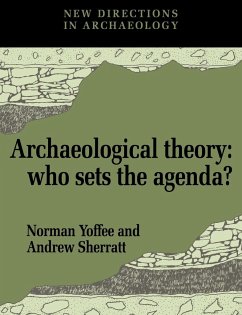Norman Yoffee / Andrew Sherratt (eds.)Who Sets the Agenda?
Archaeological Theory
Who Sets the Agenda?
Herausgeber: Yoffee, Norman; Ashmore, Wendy; Sherratt, Andrew
Norman Yoffee / Andrew Sherratt (eds.)Who Sets the Agenda?
Archaeological Theory
Who Sets the Agenda?
Herausgeber: Yoffee, Norman; Ashmore, Wendy; Sherratt, Andrew
- Broschiertes Buch
- Merkliste
- Auf die Merkliste
- Bewerten Bewerten
- Teilen
- Produkt teilen
- Produkterinnerung
- Produkterinnerung
This volume assesses current archaeological theories and considers how they relate to our understanding of the past.
This volume assesses current archaeological theories and considers how they relate to our understanding of the past.
Produktdetails
- Produktdetails
- Verlag: Cambridge University Press
- Seitenzahl: 152
- Erscheinungstermin: 15. Februar 2005
- Englisch
- Abmessung: 246mm x 189mm x 8mm
- Gewicht: 309g
- ISBN-13: 9780521449588
- ISBN-10: 0521449588
- Artikelnr.: 21805391
- Herstellerkennzeichnung
- Libri GmbH
- Europaallee 1
- 36244 Bad Hersfeld
- gpsr@libri.de
- Verlag: Cambridge University Press
- Seitenzahl: 152
- Erscheinungstermin: 15. Februar 2005
- Englisch
- Abmessung: 246mm x 189mm x 8mm
- Gewicht: 309g
- ISBN-13: 9780521449588
- ISBN-10: 0521449588
- Artikelnr.: 21805391
- Herstellerkennzeichnung
- Libri GmbH
- Europaallee 1
- 36244 Bad Hersfeld
- gpsr@libri.de
Introduction: The sources of archaeological theory Norman Yoffee, and
Andrew Sherratt; Part I. The Social Context of Archaeological Theory: 1.
Limits to a post-processual archaeology (or The dangers of a new
scholasticism) Philip L. Kohl; 2. A proliferation of new archaeologists
'Beyond objectivism and relativism' Alison Wylie; 3. Ambition, deference,
discrepancy, consumption; the intellectual background to a post-processual
archaeology Christopher Chippendale; Part II. Archaeological Theory from
the Paleolithic to the State: 4. Ancestors and agendas Clive Gamble; 5.
After social evolution: a new archaeological agenda? Stephen Shennan; 6.
Too many chiefs? (or, Safe texts for the 90s) Norman Yoffee; Part III.
Case-Studies in Archaeological Theory and Practice; 7. When is a symbol
archaeologically meaningful? Meaning, function and prehistoric visual arts
Kelley Hays; 8. Re-fitting the 'cracked and broken facade': the case for
empiricism in post-processual ethnoarchaeology Miriam Start; 9.
Communication and the importance of disciplinary communities: who owns the
past? Tim Murray; Part IV. Postscript and Epilogue: 10. The relativity of
theory Andrew Sherratt; 11. Archaeology: the loss of nerve Richard Bradley.
Andrew Sherratt; Part I. The Social Context of Archaeological Theory: 1.
Limits to a post-processual archaeology (or The dangers of a new
scholasticism) Philip L. Kohl; 2. A proliferation of new archaeologists
'Beyond objectivism and relativism' Alison Wylie; 3. Ambition, deference,
discrepancy, consumption; the intellectual background to a post-processual
archaeology Christopher Chippendale; Part II. Archaeological Theory from
the Paleolithic to the State: 4. Ancestors and agendas Clive Gamble; 5.
After social evolution: a new archaeological agenda? Stephen Shennan; 6.
Too many chiefs? (or, Safe texts for the 90s) Norman Yoffee; Part III.
Case-Studies in Archaeological Theory and Practice; 7. When is a symbol
archaeologically meaningful? Meaning, function and prehistoric visual arts
Kelley Hays; 8. Re-fitting the 'cracked and broken facade': the case for
empiricism in post-processual ethnoarchaeology Miriam Start; 9.
Communication and the importance of disciplinary communities: who owns the
past? Tim Murray; Part IV. Postscript and Epilogue: 10. The relativity of
theory Andrew Sherratt; 11. Archaeology: the loss of nerve Richard Bradley.
Introduction: The sources of archaeological theory Norman Yoffee, and
Andrew Sherratt; Part I. The Social Context of Archaeological Theory: 1.
Limits to a post-processual archaeology (or The dangers of a new
scholasticism) Philip L. Kohl; 2. A proliferation of new archaeologists
'Beyond objectivism and relativism' Alison Wylie; 3. Ambition, deference,
discrepancy, consumption; the intellectual background to a post-processual
archaeology Christopher Chippendale; Part II. Archaeological Theory from
the Paleolithic to the State: 4. Ancestors and agendas Clive Gamble; 5.
After social evolution: a new archaeological agenda? Stephen Shennan; 6.
Too many chiefs? (or, Safe texts for the 90s) Norman Yoffee; Part III.
Case-Studies in Archaeological Theory and Practice; 7. When is a symbol
archaeologically meaningful? Meaning, function and prehistoric visual arts
Kelley Hays; 8. Re-fitting the 'cracked and broken facade': the case for
empiricism in post-processual ethnoarchaeology Miriam Start; 9.
Communication and the importance of disciplinary communities: who owns the
past? Tim Murray; Part IV. Postscript and Epilogue: 10. The relativity of
theory Andrew Sherratt; 11. Archaeology: the loss of nerve Richard Bradley.
Andrew Sherratt; Part I. The Social Context of Archaeological Theory: 1.
Limits to a post-processual archaeology (or The dangers of a new
scholasticism) Philip L. Kohl; 2. A proliferation of new archaeologists
'Beyond objectivism and relativism' Alison Wylie; 3. Ambition, deference,
discrepancy, consumption; the intellectual background to a post-processual
archaeology Christopher Chippendale; Part II. Archaeological Theory from
the Paleolithic to the State: 4. Ancestors and agendas Clive Gamble; 5.
After social evolution: a new archaeological agenda? Stephen Shennan; 6.
Too many chiefs? (or, Safe texts for the 90s) Norman Yoffee; Part III.
Case-Studies in Archaeological Theory and Practice; 7. When is a symbol
archaeologically meaningful? Meaning, function and prehistoric visual arts
Kelley Hays; 8. Re-fitting the 'cracked and broken facade': the case for
empiricism in post-processual ethnoarchaeology Miriam Start; 9.
Communication and the importance of disciplinary communities: who owns the
past? Tim Murray; Part IV. Postscript and Epilogue: 10. The relativity of
theory Andrew Sherratt; 11. Archaeology: the loss of nerve Richard Bradley.


